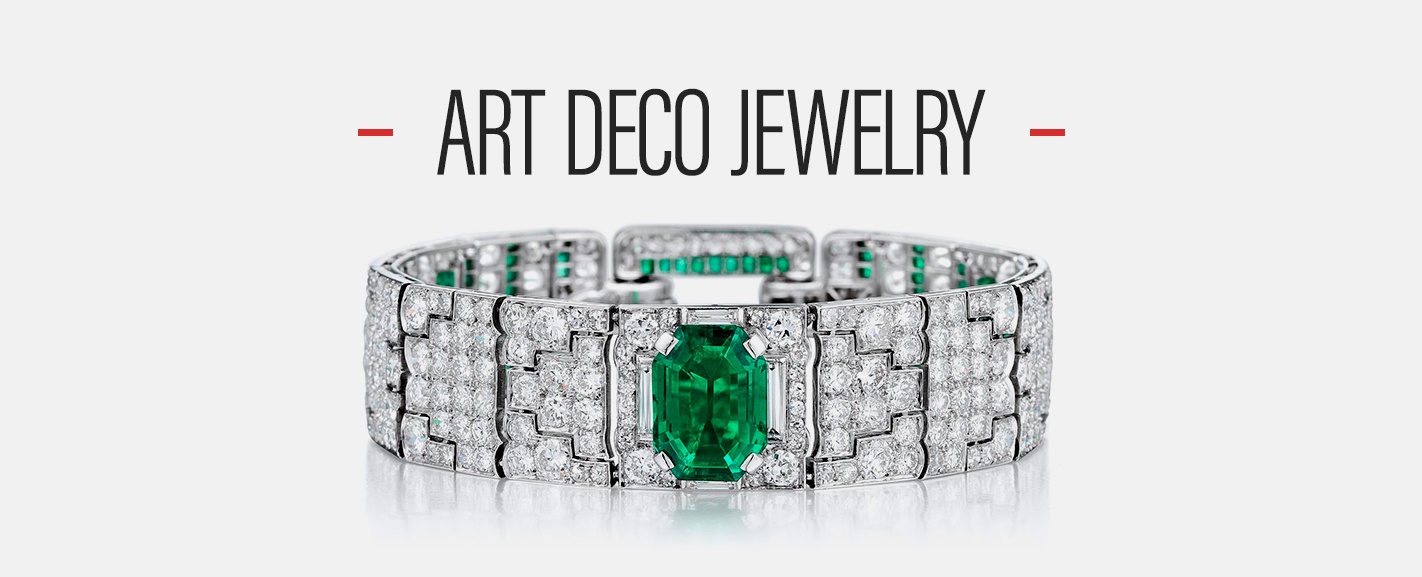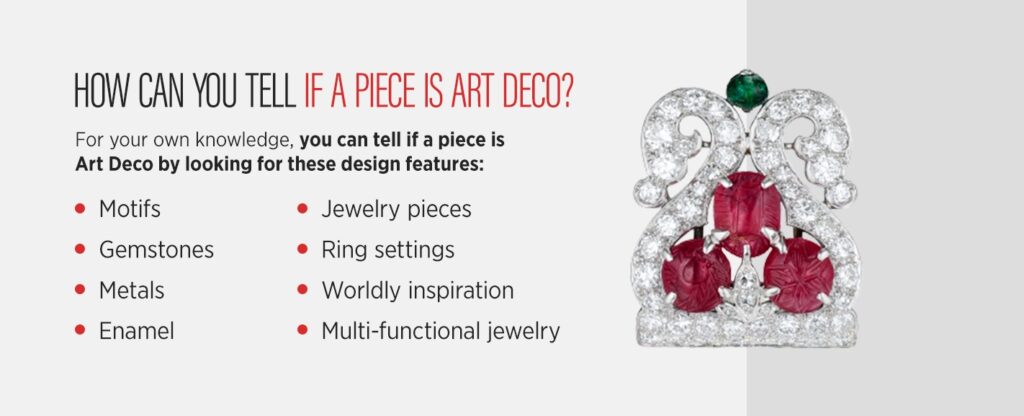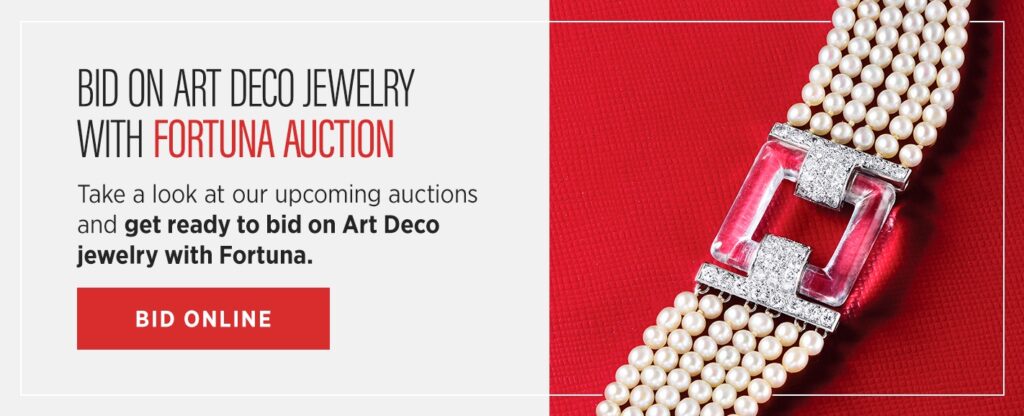
Art Deco Jewelry
If you want timeless jewelry that falls on the cusp of vintage and antique, consider Art Deco. With its iconic and recognizable style, Art Deco jewelry has been many collectors’ favorite era for quite some time. Add touches from the Roaring ’20s to your jewelry collection and learn more about this design era below.
What Is Art Deco Jewelry?
The Art Deco era spanned from 1920 to 1945, including creations and art forms from fashion, architecture, interior design and jewelry. Art Deco jewelry was particularly prominent between the ’20s and ’30s. This period was marked with celebration, as the era came after World War I. Designs were bold, fun and unique to celebrate and reflect individuality.

How Can You Tell if a Piece Is Art Deco?
Art Deco has a distinct style that differentiates it from design periods before and after it. Art Deco saw the creation of jewelry in more masculine styles, from the shapes and motifs to gemstones used. Buying from dependable sellers and auction houses can ensure you get genuine Art Deco jewelry. For your own knowledge, you can tell if a piece is Art Deco by looking for these design features:
- Motifs: Design trends before the Art Deco period featured feminine, romantic and natural inspiration. The ’20s, ’30s and ’40s broke away from those trends. Instead, motifs were sharp and sought to imagine the future. Sleek lines, triangles, rectangles and geometric shapes graced pieces of jewelry from this era. Sunburst patterns were also popular, mixing the essence of rounded designs with straight features.
- Gemstones: Diamonds were the focus in Art Deco styles, but precious gemstones and other stones were also commonly put on display. Rubies, emeralds, sapphires, onyx and carnelian shine within the era’s bold and fun uses of color.
- Metals: Art Deco interior design and architecture featured dazzling gold, but jewelry focused on white gold and platinum. White jewelry was popular during this era as designers paired diamonds with white- or silver-toned metals.
- Enamel: Along with the traditional jewelry materials came the rise of enamel. The process involved melting powdered glass onto metal. Enameling allowed jewelers to add a variety of fun colors and sophisticated contrast to their pieces.
- Jewelry pieces: While just about every type of jewelry made an appearance during this era, it did have popular styles. Long pendants, long earrings, cocktail rings, diamond watches, layered bangles and detailed accessories like brooches appear in the Art Deco era. The jewelry suited the fashion of the time, which featured lower necklines and shorter hairstyles.
- Ring settings: If you are looking for Art Deco rings, you’ll want to understand the typical settings you’ll see in this era of jewelry. Cluster settings group a selection of gemstones, often diamonds, into a dazzling design. A prong setting uplifts a gemstone, which makes it appear larger. Those two designs followed a trend of making a gemstone appear larger than it was, giving jewelry buyers the look of more diamond for their money during hard times. Box settings follow the motifs of Art Deco’s geometrical designs with a squared setting.
- Worldly inspiration: In this era, jewelry designers gained a more worldly view and translated that into their creations. Japanese, Chinese and Egyptian art inspired unique motifs, materials and processes. Jade and coral make appearances in Art Deco jewelry, as well as dragon and pagoda motifs.
- Multi-functional jewelry: Another design trend inspired by hard times was jewelry that served multiple purposes. Items like double-clip brooches, for instance, could be worn as one piece or separated to accent collars, lapels or belts.
Who Are the Most Common Designers of Art Deco?
By the Art Deco era, jewelry was seen as a way to express individuality. Jewelry collectors and everyday people alike wanted accessories that put their one-of-a-kind style on display. Plenty of designers and jewelers sought to meet the Art Deco trends and give people the unique pieces they wanted. If you’re searching for antique or vintage Art Deco jewelry, you’ll come across a variety of designers, many of whom you may recognize. Among the most common and famous designers of Art Deco jewelry are:
- Cartier: Though not the oldest, Cartier is among the most renowned jewelry houses in the world and is the most well-known of the Art Deco era. The jewelry house began as a watch company in 1847 with founder Louis-Francois Cartier. His grandsons later transformed the company into a global brand. Cartier designs for Art Deco rings attracted the world’s attention and that of royal families. Maison Cartier pioneered the use of platinum in jewelry, using the innovation to craft rings, tiaras and watches.
- Tiffany & Co.: Another recognizable jewelry house, Tiffany & Co. was founded in 1837. This jewelry house embraced the Art Deco style and trends. Tiffany & Co. was known for creating engagement rings, various jewelry pieces and even interior decorations. Many Tiffany & Co. pieces include dazzling diamonds and common geometrical features. You’ll also find emeralds and other precious gemstones.
- J.E. Caldwell: This jewelry retailer is well-known for James Emmott Caldwell’s creations during the Art Nouveau era. That period preceded Art Deco, but J.E. Caldwell would become synonymous with the ’20s design era. J.E. Caldwell’s designs are among famous and superior Art Deco pieces. The most common styles included diamond rings, which reflected cluster and box settings of the time. The retailer also created emerald rings, diamond and pearl necklaces and other items coveted for their quality.

What Are the Most Common Pieces of Art Deco?
In recent years, a cultural interest in the Roaring ’20s sparked a desire for antique and vintage Art Deco jewelry. That intrigue has made this style easier to find at vintage jewelry retailers and auction houses.
You’ll often find Art Deco pieces featuring diamonds. In prior eras, diamonds were on the decline, but the post-World War I jewelry scene saw an influx of diamonds to use in unique designs. Common pieces of Art Deco jewelry that hold assortments of the dazzling gemstone and others include:
- Brooches: Clip brooches, in particular, created a stunning canvas. Jewelers decorated brooches with geometric details, diamonds and precious gemstones.
- Sautoir necklaces: Long necklaces with tassel details were common during this era. Several designers created diamond necklaces that suspended a seed pearl tassel.
- Wide bracelets: From flexible options to cuff styles, wide bracelets were common during this period. Among the rare designs are Suzanne Belperron’s chalcedony bracelets and other pieces.
- Rings: Styles from cocktail rings to engagement varieties dominated the Art Deco era. These are common pieces to find today, especially if you’re looking for an engagement ring.
Bid on Art Deco Jewelry With FORTUNA®
If you want to expand your Art Deco jewelry collection or begin one, FORTUNA is ready to help. We offer a rare assortment of vintage and antique items in our auctions. Many of these stunning pieces come from the Art Deco period. Bidding on jewelry from decades ago is an exciting endeavor, and we want to make it as transparent and hassle-free as possible. That’s why we provide detailed photos and descriptions of everything up for auction before the bidding begins. You’ll get to browse everything beforehand and read the specifications our specialists verify.
Take a look at our upcoming auctions and get ready to bid on Art Deco jewelry with FORTUNA. Bid in-person at our New York City location, online, over the phone or as an absentee. No matter how you bid, you’ll have the opportunity to add stunning Art Deco pieces to your collection.
